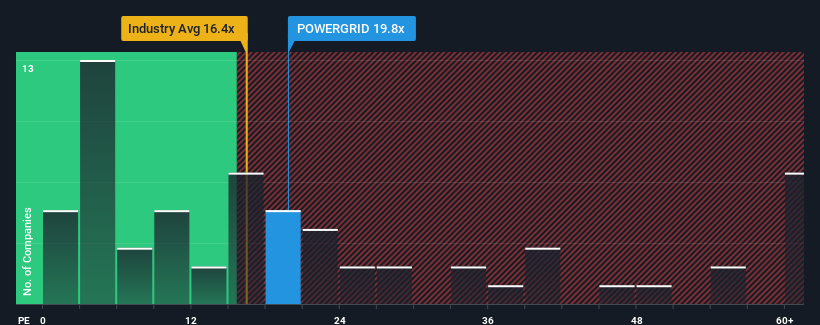- India
- /
- Electric Utilities
- /
- NSEI:POWERGRID
Why Investors Shouldn't Be Surprised By Power Grid Corporation of India Limited's (NSE:POWERGRID) Low P/E
When close to half the companies in India have price-to-earnings ratios (or "P/E's") above 34x, you may consider Power Grid Corporation of India Limited (NSE:POWERGRID) as an attractive investment with its 19.8x P/E ratio. However, the P/E might be low for a reason and it requires further investigation to determine if it's justified.
Power Grid Corporation of India could be doing better as it's been growing earnings less than most other companies lately. It seems that many are expecting the uninspiring earnings performance to persist, which has repressed the P/E. If you still like the company, you'd be hoping earnings don't get any worse and that you could pick up some stock while it's out of favour.
Check out our latest analysis for Power Grid Corporation of India

Does Growth Match The Low P/E?
The only time you'd be truly comfortable seeing a P/E as low as Power Grid Corporation of India's is when the company's growth is on track to lag the market.
Taking a look back first, we see that the company managed to grow earnings per share by a handy 3.1% last year. Still, lamentably EPS has fallen 1.8% in aggregate from three years ago, which is disappointing. Accordingly, shareholders would have felt downbeat about the medium-term rates of earnings growth.
Shifting to the future, estimates from the twelve analysts covering the company suggest earnings should grow by 5.8% each year over the next three years. Meanwhile, the rest of the market is forecast to expand by 20% per year, which is noticeably more attractive.
In light of this, it's understandable that Power Grid Corporation of India's P/E sits below the majority of other companies. It seems most investors are expecting to see limited future growth and are only willing to pay a reduced amount for the stock.
What We Can Learn From Power Grid Corporation of India's P/E?
We'd say the price-to-earnings ratio's power isn't primarily as a valuation instrument but rather to gauge current investor sentiment and future expectations.
We've established that Power Grid Corporation of India maintains its low P/E on the weakness of its forecast growth being lower than the wider market, as expected. At this stage investors feel the potential for an improvement in earnings isn't great enough to justify a higher P/E ratio. It's hard to see the share price rising strongly in the near future under these circumstances.
And what about other risks? Every company has them, and we've spotted 2 warning signs for Power Grid Corporation of India you should know about.
You might be able to find a better investment than Power Grid Corporation of India. If you want a selection of possible candidates, check out this free list of interesting companies that trade on a low P/E (but have proven they can grow earnings).
New: Manage All Your Stock Portfolios in One Place
We've created the ultimate portfolio companion for stock investors, and it's free.
• Connect an unlimited number of Portfolios and see your total in one currency
• Be alerted to new Warning Signs or Risks via email or mobile
• Track the Fair Value of your stocks
Have feedback on this article? Concerned about the content? Get in touch with us directly. Alternatively, email editorial-team (at) simplywallst.com.
This article by Simply Wall St is general in nature. We provide commentary based on historical data and analyst forecasts only using an unbiased methodology and our articles are not intended to be financial advice. It does not constitute a recommendation to buy or sell any stock, and does not take account of your objectives, or your financial situation. We aim to bring you long-term focused analysis driven by fundamental data. Note that our analysis may not factor in the latest price-sensitive company announcements or qualitative material. Simply Wall St has no position in any stocks mentioned.
About NSEI:POWERGRID
Power Grid Corporation of India
An electric power transmission utility, engages in the power transmission business in India and internationally.
Average dividend payer with mediocre balance sheet.
Market Insights
Community Narratives


Recently Updated Narratives

TAV Havalimanlari Holding will fly high with 25.68% revenue growth


Fiducian: Compliance Clouds or Value Opportunity?


Q3 Outlook modestly optimistic
Popular Narratives


MicroVision will explode future revenue by 380.37% with a vision towards success


The company that turned a verb into a global necessity and basically runs the modern internet, digital ads, smartphones, maps, and AI.



